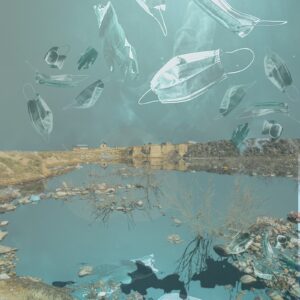Abstract
In the face of growing food demand and continued environmental degradation, agricultural practices that preserve ecosystem services are growing. Nongovernmental organizations have taken a market-based approach, introducing certification programs which compensate farmers who adhere to sustainability standards for their consequent reductions in yield by charging consumers a price premium. We conduct a choice experiment to test consumers’ willingness to pay for such eco-labeled products. The choice experiment presented consumers with five discrete choices that varied according to three attributes: price, certification, and country of origin. The experiment tests two specific ecosystem-friendly certifications, Rainforest Alliance and Smithsonian Bird Friendly Certification by Smithsonian Migratory Bird Center, as well as two alternative certifications, Fair Trade and USDA Organic. We find that consumers are willing to pay a price premium up to 300-450% for eco-labeled products over Organic or Fair Trade products. Between the two eco-labeled products, consumers prefer Rainforest Alliance over Smithsonian Bird Friendly.
Motivation and Background
Ecosystem services are categorized into four broad categories: providing goods, regulating systems, supporting natural mechanisms, and providing cultural benefits.[1] Modern agricultural practices have been successful in providing values for the provision of goods for which markets exist, such as crops, livestock, fish, and forest products. But the expansion of agricultural practices has often been achieved at a high cost to other, non-market, regulatory ecosystem services, such as climate control, biodiversity preservation, and maintenance of water quality.[2] In the face of growing food demand, along with the recognition that ecosystems play an important role in human welfare and that humans have an impact on these services, economists have attempted to quantify the value of environmental services. Serious challenges exist, however, in the quantifying the values of these services: the complexity of ecosystems, our limited understanding of their interactions with each other, the indirect nature of the benefits these services provide, as well as fundamental disagreements about how value should be defined.
Despite the fact that it is difficult to quantify these measures, there is general agreement that ecosystems must be preserved, or at the very least, managed more sustainably, in order to meet the growing demand for food in the world. The world population is expected to grow by over a third by 2050, and per capita incomes are expected to increase. FAO projections show that feeding a world population of 9.1 billion people in 2050 would require raising overall food production by some 60 percent by that time. This would mean almost a doubling of food production in developing countries. Considering the fact that 33% of land globally is used for agriculture,[3] farmers are the largest group of natural resource managers. They depend on and generate ecosystem services.[4] Therefore, any attempt at preserving ecosystem services must incorporate agriculture and farmers.
There are two general methods of farming to preserve ecosystem services. Land-sparing methods concentrate production by intensively farming a small area of land, therefore reducing the need to farm more extensively to have the same amount of yield. Alternatively, land-sharing methods retain patches of natural habitat while farming on a less intensive scale, therefore preserving some of the biodiversity of the land while farming. This method, however, reduces yields: for the method to be sustainable, farmers have to either farm larger patches of land to have the same yields or be compensated for their losses.[5] A meta-analysis of biodiversity and ecosystem services conservation programs on coffee and cacao plantations shows that the former intensification method decrease biodiversity richness and ecosystem services.[6]
Due to their non-excludable and non-rival nature, meaning one cannot easily exclude someone from consuming the good and the consumptions by one person does not prevent the consumption of the other, public goods are the hardest to manage and regulate. When it comes to agricultural land, since the land is owned by an individual or a group (i.e. the property rights are well defined), government regulation becomes easier: the farmers can be incentivized to adopt more environmentally friendly practices. Most payment for ecosystem service programs today are funded by government agencies and are designed to provide public funds to farmers as compensation for foregoing more intensive and profitable practices in order to reduce environmental degradation.[7] The challenge with paying for ecosystem services lies in the fact that the consumers, or buyers, are not necessarily the only beneficiaries. While benefits of the ecosystem service, like climate control, are enjoyed by everyone, the burden of cost unevenly falls to either the consumers, or the governments that fund such programs.[8]
NGOs, such as the Rainforest Alliance and Smithsonian Migratory Bird Center, have taken a market-based approach to paying for ecosystem services by introducing certification programs that, by charging a price premium, attempt to turn beneficiaries into consumers (direct buyers) of the service. Charging a premium on certified products allows farmers who adhere to sustainability standards to be compensated to offset the losses they incur while conserving natural landscapes.
One of the more popular agricultural products for eco-labeling is coffee. Coffee is one of the world’s most traded commodities and the world’s third largest consumed beverage after water and tea. Traditionally, it has been shade-grown. After the Green Revolution of the mid-20th century, which encouraged the adoption of agricultural practices that increase yields through the use of fertilizers, pesticides, and high-yield crop varieties, most coffee farmers switched to plantation management techniques for increased yields.[9] Today, there is a trend among growers to return to the shade-grown method of producing coffee: it is considered more environmentally friendly because shade-growing protects regional biodiversity, conserving tree cover and thus maintaining areas where animals can continue to live and migrating birds can stop over.
As mentioned above, there are two major eco-labels for coffee: Smithsonian Bird Friendly Certification and Rainforest Alliance Certification. Smithsonian Bird Friendly Certification is the only certification that has specific requirements for shade-grown coffee, including 12 meters of height for tree canopy, a minimum of 40% of shade coverage, and 10 woody species. All production must also be organic. According to the data from BirdLife International’s World Bird Database, farming is the single biggest threat to bird species, especially in developing countries;[10] thus the Smithsonian’s stringent certification criteria focus specifically on tree cover to protect migratory birds. On the other hand, the Rainforest Alliance certification takes on a more holistic approach: its criteria consider planning and management practices and effects on producers’ livelihoods in addition to the conservation of biodiversity and natural resources.[11] Unfortunately, their newest standards are not available online and there is limited information on their website for a more thorough comparison. Regardless, the differences, and therefore the tradeoffs between environmental and social benefits for consumers, are clear from these broad criteria.
To assess the tradeoffs consumers face when making purchasing decisions, we conducted a choice experiment to assign value to ecosystem services from the consumer perspective. In this paper, we conducted a choice experiment to test if consumers are willing to pay more for ecosystem friendly products, as measured by their willingness to pay for certified shade-grown coffee. Ecosystem friendly products are defined as those products whose production minimizes negative effects on the environment.
It is important to note that the direct values derived as a result of this choice experiment illustrates consumer preferences, but not necessarily the actual value of the ecosystem service. There are two reasons we cannot make this conclusion. One is that, due to the limited number of surveys, the nonrepresentative sample (limited to Ithaca, NY), and how the choice experiment was designed without a constant “business as usual” option, the results do not necessarily represent a direct value on the ecosystem services. Two, research by Boxall, et al. has found significant differences in values stated between contingent valuation experiments – a method of estimating the value a person places on a good – and choice experiments, especially in environmental contexts. While both methods require individuals to state their preferences for environmental qualities, Boxall, et al. found that respondents usually ignored substitutes in the contingent valuation questions, meaning they may overstate their willingness to pay.[12] For these reasons, the choice experiment merely illustrates consumer preferences and the compromises consumers have to make when making purchasing decisions.
Research has shown that consumers are willing to pay more for eco-labeled products if they perceive the products to be of a higher quality.[13] We assume that consumers would be willing to pay more for ecosystem-friendly products because those products not only offer benefits to the consumers as indirect-use beneficiaries of these services but also offer benefits to the farmers in the form of increased incomes. Taking into consideration some realistic tradeoffs consumers make when making purchasing decisions, in addition to Rainforest Alliance and Smithsonian Bird Friendly Certifications, we include Fair Trade and Organic certifications.
Beneficiaries may value environmental services on account of directly using them (such as using timber from the forest), indirectly using them (benefiting from climate regulation), or having the option to use them (knowing you will one day visit the forest), or non-use or existence values, where one places value on simply knowing that the ecosystem exists. The certification programs attempt to put a value on the indirect use and the option value of ecosystem services by charging a premium on coffee that has been grown in a more ecosystem-friendly way. In a consumer behavior study, Larouche, et al. found that consumers who are most likely to pay a premium for environmentally-friendly products are female, married, and have at least one child living at home. The consumers reported that today’s ecological problems are severe and that behaving in an environmentally-friendly fashion is important.[14] More specifically, Loureiro and Lotade found that in face-to-face interviews about consumer preferences regarding ethical and environmental labels in coffee, consumers are willing to pay higher premiums. Based on our results, we extrapolate from previous research that consumers are willing to pay higher prices for any perceived increase in quality and benefits to the environment. By testing for both the Rainforest Alliance and Smithsonian Bird Friendly Certifications, we find that consumers are also willing to pay a price premium for social benefits.
Methodology and Sampling
We conducted a stated preference choice experiment to assess the effects of certification labels regarding product attributes and production practices on consumers’ willingness to pay for a cup of coffee. The survey also included questions regarding respondents’ demographic characteristics, ecosystem-friendly purchasing behavior, and coffee purchasing behavior. The full survey can be found in Appendix C. Hard copies of the survey were distributed at several coffee shops in downtown Ithaca, New York, and several locations at the Cornell University campus. We chose these two locations to target both coffee drinkers and non-coffee drinkers from as wide a variety of age and socioeconomic status as possible. The survey took respondents an average of 10 minutes to complete. We collected a total of 50 complete responses between April 24 and April 30, 2016.
Experimental Design
The survey consisted of five choice sets with the option to select a bundle of attributes from each set, as well as an opt-out option. Each choice set contained three bundles, accounting for the coffee’s price, its country of origin, and certification: Fair Trade International, the Rainforest Alliance, the Smithsonian Bird Friendly Center, and USDA (United States Department of Agriculture) Organic. The choice between the Rainforest Alliance and the Smithsonian Bird Friendly Certification was one point of interest. The other point of interest was the respondents’ preferences between these two ecosystem-friendly products and the other two environmentally or socially beneficial labels of USDA Organic and Fair Trade. Each choice attribute was randomized across all choice sets. Respondents were instructed that all other product attributes, such as size and quality, were identical.
Following a brief series of questions regarding consumer behavior, respondents were given information about what shade-grown coffee is, and full information on what each certification achieves.
Price
Across choice sets, the price was randomized in a range from $0.75 to $2.00, with 25 cents increments between the choices. The price was indicated for “a cup of coffee.” These price levels are comparable to prices for 16oz cups of coffee in Ithaca coffee shops and Cornell University coffee shops and dining facilities.
Certifications
The certifications tested included two ecosystem friendly certifications, Rainforest Alliance and Bird Friendly Certification by Smithsonian Migratory Bird Center. We chose these two certifications because they are the best-known ecosystem-friendly certifications that have specific criteria for shade-grown coffee. To provide respondents with realistic alternatives, these certifications were tested against two alternative certifications, Fair Trade and USDA Organic, which do not have specific criteria for shade-grown coffee but emphasize other criteria—supporting producers and sustainable environmental farming practices and helping organic agriculture grow, respectively. Information provided to the respondents on each certification specifications can be found in Appendix C.
Country of Origin
The countries of origin were chosen based on the countries where all four of the above mentioned certification agencies operate. These include Colombia, Guatemala, and Nicaragua. Each of these countries has large land areas supporting diverse ecosystems. The fact that they are all from Latin America also eliminates biases between more varied geographic locations, like coffee grown in Africa or Southeast Asia, allowing us to focus more specifically on the preferences among the eco-labels.
Empirical Strategy and Findings
Summary Statistics
We surveyed 50 respondents, which gave us, with 5 sets of 3 choices, a total of 750 observations. As shown in Appendix A, Table 2, the majority of respondents were graduate students (50.83%), female (69.83%) and US nationals (67.7%). 48.7% of respondents said that they were somewhat familiar with products that preserve ecosystems, and 36.7% said that they frequently buy ecosystem-friendly products. 91% of the respondents were coffee-drinkers: 30.1% reported drinking 7-10 cups of coffee per week, and 42.5% spend more than $20 on coffee per month.
Conditional Logit Model Results
We estimated a conditional logit model to test how product attributes affect choice. We omitted 24 observations from our analysis for which no preference was selected among the three options in a choice set. In addition, Nicaragua was omitted due to collinearity. The generated coefficients for product attributes and label attributes are presented in Appendix A, Table 3; variable names and descriptions are presented in Appendix A, Table 1. All statistical steps in conducting the analysis are shown in the State do-files in Appendix B.
Although the coefficient on price is not significant at confidence level 0.05, it is negatively correlated to a choice, meaning as price increased, a bundle was less likely to be chosen. The coefficients on all other variables are positive and statistically significant. Respondents were more likely to choose a bundle according to the specifications,th, regardless of the certification and country of origin. In fact, the certifications had larger coefficients than countries of origin, which reflects that consumers were more likely to base their willingness to pay for certain products on label attributes that imply positive environmental and social production practices than to base their purchasing decisions on the products’ countries of origin.
Further, to test for trends regarding different combinations of attributes, we introduced several interaction variables by grouping attributes in twos and threes. While most of these interaction variables were not statistically significant, the interaction terms including Rainforest Alliance and Colombia were significant at the 95% confidence interval level and positive,(see Appendix A, Table 4, Rainforest Alliance_Organic_Colombia and Rainforest Alliance_Fair Trade_Colombia). The conditional logit model found that respondents were more likely to choose a coffee certified by Rainforest Alliance and originating from Colombia. This tells us that respondents prefer eco-labeled coffee certified by Rainforest Alliance over coffee with Smithsonian Bird Friendly Certification. In later tests, when we introduced an interaction variable including all four attributes, meaning a product that had all four attributes (Rainforest Alliance, Organic, Fair Trade, and Colombia), the results were dropped due to collinearity.
Price Premium
When we calculate the probability that consumers will choose eco-labeled coffee over other coffee products, we find that there is a willingness to pay a high price premium for eco-labeled products. Keeping the country of origin (Colombia) and the Organic certification constant, respondents were more likely to select eco-labeled coffee over Fair Trade-labeled coffee up to 450% price premium. When comparing the two eco-labeled products, consumers were more likely to select Rainforest Alliance over Smithsonian Bird Friendly up to a 150% price premium, regardless of country of origin. Finally, when comparing the more popular Rainforest Alliance option with the Organic product, we find that consumers were more likely to select Rainforest Alliance up to a 200% price premium. In all cases, the willingness to pay a price premium decreased as the markup prices increased. Appendix A, Table 5 provides a matrix of price markups and an estimation of the maximum likelihood of selection. As stated above, these probabilities and the price mark ups should be evaluated with a critical eye, and are meant to simply show ranked preferences not exact values.
Conclusion and Policy Implications
It is clear from these findings that consumers are willing to a pay a steep price premium for eco-labeled products that are ecosystem-friendly, rather than organic products or products that provide socioeconomic benefits like Fair Trade certification. Between the two eco-labeled products, consumers clearly prefer Rainforest Alliance over Smithsonian Bird Friendly Certifications, even though the Smithsonian Certification criteria are more stringent and have higher standards for ecosystem protection. This preference may be due to two reasons. First, in addition to their preference for preserving ecosystems, consumers may also care about the added benefits Rainforest Alliance brings in terms of labor relations and workers’ well-being. Respondents could be willing to trade off some ecosystem preservation in exchange for supporting workers’ rights. Second, consumers may be confused regarding the exact benefits each certification brings due to the limited information given to respondents. Based on anecdotal evidence, we believe that consumers are more familiar with Rainforest Alliance brand than the Smithsonian Bird Friendly brand. In a follow-up survey, it would be interesting to test whether prior exposure to a certification influences the results.
When looking at the interaction variables, we find that in addition to Organic, the only statistically significant variables were those that interacted with Rainforest Alliance and Colombia. This also adds to our belief that people have a preference for these two attributes due to their branding and name recognition. Despite the fact that we asked participants to assume all quality attributes are the same, Colombian coffee is simply more recognizable than Guatemalan and Nicaraguan coffee. Colombia produces over twice as much coffee annually as Guatemala and Nicaragua combined.[15] Similarly, Rainforest Alliance as a brand is well-known outside of the coffee market.
Regardless, the fact that consumers are willing to pay such a high price premium for eco-labeled products sends a favorable signal to certifying agencies. Market-based solutions are a viable alternative or a supplement to publicly-funded Payment for Ecosystem Services (PES) programs. By converting beneficiaries into consumers, the buyers are more directly linked to these services.
However, any expansion of this type of compensation program must come with increased transparency and accountability. First, consumers are not widely aware of what the various certification processes and requirements specifically involve. Even in the course of conducting this research paper, we found much confusion about the specific requirements needed to receive certain certifications, especially Rainforest Alliance, which makes comparison difficult.
Second, consumers are willing to pay higher price premiums on these eco-labeled products, designed to compensate farmers for their initial investments in converting to an ecosystem friendly model as well as for reduced incomes due to lower yields, there is mixed evidence regarding whether farmers themselves receive these price premiums. Due to the commodity nature of coffee, the higher premium prices may not always reach the farmers or be enough to compensate for the low yields.[16][17] Still, Altieri and Toledo found that the application of ecosystem-friendly, land-sharing methods can bring significant environmental, economic, and political benefits to farmers, especially in the Latin America context, including such benefits as restoring local self-reliance, producing healthy foods with low inputs, empowering local organizations, and conserving and generating biodiversity. If further research can link the high price premiums to these benefits, this would have significant serious policy implications in terms of linking ecosystem preservation and economic development.
Overall, increased transparency and accountability would ensure that the high price premiums that consumers are willing to pay are paid with the consumers’ full knowledge of how that investment is spent along the coffee supply chain, benefiting not only the consumers indirectly through the preservation of ecosystem services, but also benefiting the farmers and the environment. The relationship between farmers’ incomes and the ecosystem preservation goals must be kept in mind with any continued expansion of such programs.
- http://www.millenniumassessment.org/en/About.html ↑
- FAO, “The State of Food and Agriculture 2007: Paying Farmers for Environmental Services.” (Rome, Italy: Food and Agricultural Organization of the United Nations (UN FAO), 2007), http://www.fao.org/docrep/010/a1200e/a1200e00.htm. ↑
- T. Elmqvist et al., “Managing Trade-Offs in Ecosystem Services,” Working Paper (U.N. Environment Programme, Division of Environmental Policy Implementation, ESE, January 2011), http://www.unep.org/ecosystemmanagement/Portals/7/Documents/WP04_Managing. ↑
- FAO, “How to Feed the World in 2050” (Italy: Food and Agricultural Organization of the United Nations (UN FAO) High Level Expert Forum, 2009), http://www.fao.org/fileadmin/templates/wsfs/docs/expert_paper/How_to_Feed_the_World_in_2050.pdf. ↑
- R. E. Green et al., “Farming and the Fate of Wild Nature,” Science 307 (2005): 550–55. ↑
- Matthias De Beenhouwer, Raf Aerts, and Olivier Honnay, “A Global Meta-Analysis of the Biodiversity and Ecosystem Service Benefits of Coffee and Cacao Agroforestry,” Agriculture, Ecosystems & Environment 175 (2013): 1–7. ↑
- FAO, “The State of Food and Agriculture 2007: Paying Farmers for Environmental Services.” ↑
- Green et al., “Farming and the Fate of Wild Nature.” ↑
- Robert A. Rice, “A Place Unbecoming: The Coffee Farm of Northern Latin America,” Geographical Review 89, no. 4 (October 1999): 554–79. ↑
- Green et al., “Farming and the Fate of Wild Nature.” ↑
- Sustainable Agriculture Network, “Sustainable Agriculture Standard: For Farms’ and Producer Groups’ Crop and Cattle Production,” Draft Version 3 (February 2015): 5. ↑
- Peter C. Boxall et al., “A Comparison of Stated Preference Methods for Environmental Valuation,” Ecological Economics 18, no. 3 (1996): 243–53. ↑
- Maria Lus Loureiro and Jill J. McCluskey, “Consumer Preferences and Willingness to Pay for Food Labeling: A Discussion of Empirical Studies,” Journal of Food Distribution Research 34.3 (2000): 95–102. ↑
- Michel Laroche, Jasmin Bergeron, and Guido Barbaro-Forleo, “Targeting Consumers Who Are Willing to Pay More for Environmentally Friendly Products,” Journal of Consumer Marketing 18.6 (2001): 503–20. ↑
- International Coffee Organization, “Country Data on the Global Coffee Trade | #CoffeeTradeStats” August 2016, http://www.ico.org/profiles_e.asp. ↑
- Colleen Anunu, “Understanding the Coffee Supply Chain and Pricing Variables,” Online Interview 31 (March 2016). ↑
- Joni Valkila, “Fair Trade Organic Coffee Production in Nicaragua-Sustainable Development or a Poverty Trap?,” Ecological Economics 68.12 (2009): 3018–25. ↑
Appendix A: Empirical Tables
Table 1: Variable Descriptions
| Variable | Description |
| Price | The price for a 16oz cup of coffee |
| RA | Shade-grown coffee certified by Rainforest Alliance |
| Smithsonian | Shade-grown coffee certified by Smithsonian Migratory Bird Center |
| FairTrade | Coffee certified by Fair Trade International |
| Organic | Coffee certified as organic by USDA |
| Colombia | Coffee grown in Colombia |
| Guatemala | Coffee grown in Guatemala |
| Familiarity | Familiarity with products that preserve ecosystems |
| Purchase | Frequency respondent purchases ecosystem friendly products |
| Labels | Ecosystem friendly labels considered when purchasing a product |
| Contribution | Contribution to a sustainability cause |
| Claims | Preferred specification in labels |
| Coffee | Whether respondent drinks coffee or not |
| Frequency | Frequency respondent drinks |
| Expense | Expenses on coffee per month |
| Brew | Whether respondent buys coffee or brews it at home |
| Male | Gender (1 = male; 0 = female) |
| Profession | Current Profession (Professional, Graduate Student, Undergraduate Student) |
| International | Country of origin is USA (1 = yes; 0 = no)
|
Table 2: Summary Statistics from the Conditional Logit Model
| Characteristics | Frequency |
| Female | 70% |
| Graduate Student | 51% |
| US citizen | 68% |
| Somewhat familiar with eco-friendly products | 49% |
| Frequently buys ecofriendly products | 37% |
| Drinks coffee | 92% |
| Spends more than $20 per month on coffee | 43% |
| Drinks more than 5 cups of coffee per week | 55% |
Table 3:Variable Coefficients from the Conditional Logit Model
| Choice | |
| Price | -0.191 |
| (0.83) | |
| RA | 1.892 |
| (6.66)** | |
| Smithsonian | 1.280 |
| (5.44)** | |
| FairTrade | 1.876 |
| (7.46)** | |
| Organic | 1.114 |
| (3.68)** | |
| Colombia | 0.493 |
| (2.29)* | |
| Guatemala | 0.472 |
| (2.14)* | |
| N | 726 |
| * p<0.05; ** p<0.01
|
|
Table 4: Interaction Terms Coefficient from the Conditional Logit Model
| Choice | |
| Price | -0.347 |
| (0.75) | |
| RA | 1.294 |
| (1.77) | |
| Smithsonian | 0.632 |
| (0.84) | |
| FairTrade | 2.147 |
| (3.23)** | |
| Organic | 1.004 |
| (1.43) | |
| Colombia | -0.600 |
| (1.35) | |
| Guatemala | 0.197 |
| (0.47) | |
| RA_Guatemala | -0.039 |
| (0.06) | |
| Smithsonian_Colombia | 1.754 |
| (1.87) | |
| Smithsonian_Guatemala | 0.731 |
| (1.27) | |
| RA_Organic | 0.266 |
| (0.25) | |
| Smithsonian_FairTrade | -0.136 |
| (0.18) | |
| RA_Organic_Colombia | 1.604 |
| (2.43)* | |
| RA_FairTrade_Colombia | 1.354 |
| (1.96)* | |
| N | 726 |
| * p<0.05; ** p<0.01 | |
Table 5: Maximum Likelihood of Selection Estimation
| Prices | Probability of Selection | |||||
| Price Markup | Constant | Price Premium | RA over FT | Smithsonian over FT | RA over Smithsonian | RA over Organic |
| $2 | $2 | 0% | 0.869 | 0.782 | 0.648 | 0.685 |
| $3 | $2 | 50% | 0.846 | 0.748 | 0.604 | 0.643 |
| $4 | $2 | 100% | 0.819 | 0.711 | 0.557 | 0.598 |
| $5 | $2 | 150% | 0.789 | 0.670 | 0.510 | 0.551 |
| $6 | $2 | 200% | 0.755 | 0.626 | 0.462 | 0.503 |
| $7 | $2 | 250% | 0.718 | 0.581 | 0.415 | 0.456 |
| $8 | $2 | 300% | 0.678 | 0.533 | 0.370 | 0.409 |
| $11 | $2 | 450% | 0.543 | 0.392 | 0.248 | 0.281 |
Appendix B: Survey Design
This survey is voluntary. We will not ask for any identifying information. The information you give is anonymous and individual responses will be kept confidential. This survey should take less than 10 minutes to fill.
1. How familiar are you with products that preserve ecosystems (referred to as ecosystem friendly in this survey)? (Check only one box.)
- Very familiar
- Somewhat familiar
- Not very familiar
- Not at all familiar
2. Do you buy ecosystem friendly products? (Check only one box.)
- Never
- Rarely
- Frequently
- Whenever possible
- Don’t know
3. Which of the following ecosystem friendly labels do you consider when purchasing a product? (Check all that apply.)
- Organic
- Fair Trade
- Smithsonian Bird-Friendly Certification
- Rainforest Alliance
- UTZ Environmental Standards
- Made from recycled materials
- Other: _______
4. In the past year, have you contributed to a sustainability cause in any of the following ways? (Check all that apply.)
- Donated to an NGO
- Volunteered at a “green” event
- Participated in a protest/demonstration
- Changed your behavior (reduce waste, buy recycled products)
- Member of an environmental or a human rights group
5. Please indicate which of the following claims are important when you consider sustainable coffee by placing a check in the appropriate box for each statement. (Check all that apply.)
- The coffee you buy is grown using environmentally sustainable growing practices.
- The farmers growing the coffee you buy can experience a higher standard of living.
- The coffee is grown and marketed with respect to traditional cultures.
- The program encourages more coffee growers to participate in the labeling program.
6. Sustainable products can be certified by a number of different agencies. Which type of organization would you most prefer to certify the claims made on sustainable coffee labels? (Check only one box.)
- U.S. Government Agency (e.g. U.S. Department of Agriculture)
- Other Government Agency (e.g. Smithsonian)
- Environmental NGO (e.g. Rainforest Alliance)
- Country-of-origin Industry Group (e.g. Colombian Coffee Growers Association)
- Retail (e.g. Local Coffee Shop)
- Don’t Know
7. Do you drink coffee?
- Yes
- No
8. On average, how many cups of coffee do you drink per week? (Check only one box.)
- 0-1
- 2-4
- 5-7
- 7-10
- More than 10
9. On average, how much do you spend per month on coffee? (Check only one box.)
- $0-1
- $2-$5
- $6 – $10
- $11 – $20
- More than $20
10. Do you typically buy your coffee by the cup, or brew your own? (Check only one box.)
- Brew my own
- Buy by the cup on campus
- Buy by the cup off campus
- An even mix of all of the above
- I don’t drink coffee
In this section we would like for you to imagine that you are in your favorite coffee shop and are looking to purchase a cup of coffee. There are three different options available for you to purchase. We will ask you to repeat the choice several times.
Please assume that brand attributes are identical except for price and any information given on the labels. For example, please assume that product quality and size are the same across the three different products. If a label is left blank, then there is no information regarding whether that product meets standards or not.
What is shade grown coffee?
Shade grown coffee is a form of a beverage product from coffee plants grown under the shade of trees. Different agencies provide certifications for shade grown coffee. The certifications are aimed to promote sustainable agricultural practices, conserve biodiversity and/or support livelihoods. Farmers who adhere to these sustainability standards can then be compensated with premium prices while conserving natural landscapes. However, they are not compensated for the costs incurred to switch to new farming systems and practices, making the net economic gains uncertain.
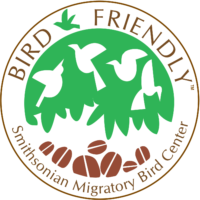 |
Smithsonian Migratory Bird Center, Bird Friendly Certification
The Bird Friendly Certification certifies 100% organic and shade grown coffee to preserve agroforests so that migratory birds can stopover on their paths. The coffee is organic and the program requires a variety of native shade trees throughout the coffee plantation. This certification has no requirements regarding treatment of workers or community relations. |
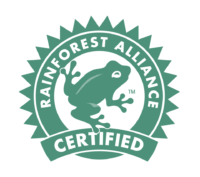 |
Rainforest Alliance
Rainforest Alliance certifies farms that operate in an environmental and social management system that takes into consideration ecosystem conservation, wildlife protection, watershed, soil, and waste management, as well as working conditions and community relations. There are no requirements for the coffee to be organic or shade grown. |
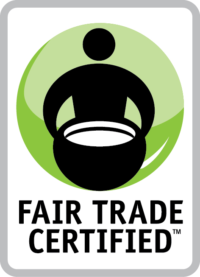 |
Fair Trade
Fair Trade is primarily concerned with alleviating poverty through greater equity in international trade. Fair Trade cooperatives receive a minimum price if the coffee is also certified organic. Neither certification has criteria related to growing coffee under shade and standards regarding wildlife are relatively generic. It does not require organic certification. |
 |
USDA Organic
Coffee sold as certified in the U.S. must be produced under U.S. standards established by the USDA’s National Organic Program. Verification is carried out by accredited certifying agencies. Requirements for this seal include no use of prohibited substances on the land for at least three years. |
11. Assume that you are going to buy a cup of coffee. If you could only choose from the following three choices, which one would you choose? (Please check only one of the boxes at the bottom of this page.)
| Coffee A | Coffee B | Coffee C |
| $2.00/cup | $1.75/cup | $1.25/cup |
|
Rainforest Alliance Certification
|
Smithsonian Bird Friendly 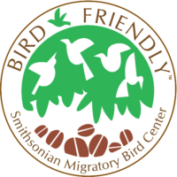 |
Fair Trade |
|
USDA Organic 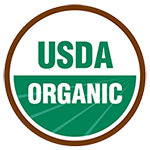
|
USDA Organic 
|
USDA Organic 
|
| Colombia | Guatemala | Nicaragua |
- Coffee A
- Coffee B
- Coffee C
- I would not buy any of these
12. Assume that you are going to buy a cup of coffee. If you could only choose from the following three choices, which one would you choose? (Please check only one of the boxes at the bottom of this page.)
| Coffee A | Coffee B | Coffee C |
| $1.75/cup | $1.75/cup | $1.50/cup |
|
Rainforest Alliance Certification
|
Smithsonian Bird Friendly
|
|
|
Fair Trade
|
Fair Trade
|
|
|
USDA Organic
|
USDA Organic
|
|
| Nicaragua | Colombia | Guatemala |
- Coffee A
- Coffee B
- Coffee C
- I would not buy any of these
13. Assume that you are going to buy a cup of coffee. If you could only choose from the following three choices, which one would you choose? (Please check only one of the boxes at the bottom of this page.)
| Coffee A | Coffee B | Coffee C |
| $2.00/cup | $2.00/cup | $1.50/cup |
|
Smithsonian Bird Friendly
|
Rainforest Alliance Certification
|
|
|
Fair Trade
|
Fair Trade
|
|
| USDA Organic
|
USDA Organic
|
|
| Colombia | Nicaragua | Guatemala |
- Coffee A
- Coffee B
- Coffee C
- I would not buy any of these
14. Assume that you are going to buy a cup of coffee. If you could only choose from the following three choices, which one would you choose? (Please check only one of the boxes at the bottom of this page.)
| Coffee A | Coffee B | Coffee C |
| $1.50/cup | $1.25/cup | $1.00/cup |
|
Rainforest Alliance Certification
|
Smithsonian Bird Friendly
|
|
|
Fair Trade
|
Fair Trade
|
|
|
USDA Organic
|
USDA Organic
|
USDA Organic
|
| Guatemala | Nicaragua | Colombia |
- Coffee A
- Coffee B
- Coffee C
- I would not buy any of these
15. Assume that you are going to buy a cup of coffee. If you could only choose from the following three choices, which one would you choose? (Please check only one of the boxes at the bottom of this page.)
| Coffee A | Coffee B | Coffee C |
| $1.00/cup | $1.00/cup | $0.75/cup |
|
Rainforest Alliance Certification
|
Smithsonian Bird Friendly
|
|
|
Fair Trade
|
||
|
USDA Organic
|
USDA Organic
|
|
| Nicaragua | Colombia | Guatemala |
- Coffee A
- Coffee B
- Coffee C
- I would not buy any of these
Different types of people may have different preferences for product labeling. The following basic demographic questions will help us understand how your preferences relate to those of the student body at large. All responses are confidential.
16. What is your gender?
- Male
- Female
17. What is your profession?
- Undergraduate Student
- Graduate Student
- Professional
18. Are you an international student?
- Yes
- No




